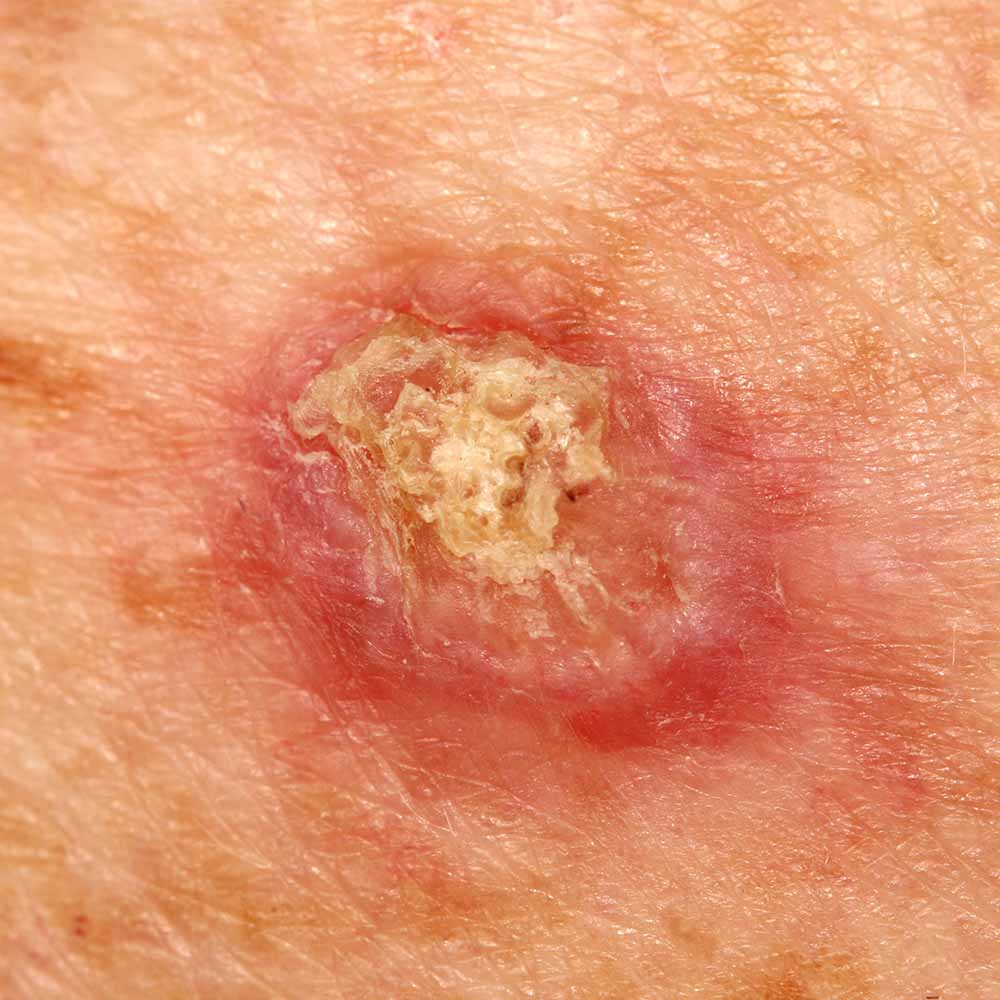Squamous Cell Carcinoma
Home • Dermatology • Skin Cancer, Pre-Cancerous Lesions & Treatment • Squamous Cell CarcinomaOverview
Squamous cell carcinoma (SCC) is the second most common type of skin cancer, with over a million cases diagnosed annually in the United States. It originates in the squamous cells, which are flat cells located in the middle and outer layers of the epidermis. SCC is generally less dangerous than melanoma but can become invasive and spread to other parts of the body if not treated promptly.
OverviewCauses
SCC primarily develops due to cumulative ultraviolet (UV) radiation exposure from sunlight or artificial sources like tanning beds. UV radiation damages the DNA in squamous cells, triggering uncontrolled cell growth.
Other contributing factors include:
- Chronic Sun Exposure: Long-term exposure to sunlight increases the risk, especially in individuals who spend significant time outdoors.
- Tanning Beds: Frequent use of tanning beds increases the likelihood of developing SCC, particularly in young adults.
- Precancerous Conditions: SCC often arises from precancerous lesions, such as actinic keratosis, which appears as rough, scaly patches on sun-exposed skin.
- Radiation Exposure: Prior radiation therapy can damage skin cells and lead to SCC development.
- Chemical Exposure: Contact with carcinogenic chemicals like arsenic increases risk.
- Weakened Immune System: People with compromised immunity, such as organ transplant recipients or those with HIV/AIDS, have a higher risk.
- Chronic Wounds or Inflammation: Long-standing scars, ulcers, or inflammatory skin conditions can evolve into SCC.
Who Is Most at Risk?
Although SCC can affect anyone, specific populations face a higher risk:
- Fair-Skinned Individuals: People with fair skin, blue or green eyes, and light-colored hair are more vulnerable, though SCC can occur in all skin tones.
- Older Adults: SCC is more common in individuals over the age of 50 due to cumulative sun exposure.
- Men: Historically, men are more likely to develop SCC, although rates among women are rising.
- Geographic Location: Living in areas with high UV exposure increases risk.
Genetic Predisposition: Conditions like Xeroderma Pigmentosum (XP) increase the risk of SCC due to an inability to repair UV-induced DNA damage.
CausesSymptoms
SCC typically develops on sun-exposed areas such as the face, ears, scalp, lips, neck, arms, and hands. It can also appear in areas not exposed to the sun, such as the genitals, especially in individuals with weakened immune systems. Common symptoms include:
- Scaly Red Patches: These areas may be rough to the touch and persist without healing.
- Open Sores: Non-healing sores that may bleed, ooze, or crust over repeatedly.
- Raised Growths or Lumps: These may have a central depression and feel tender or painful.
- Wart-Like Growths: SCC lesions can sometimes resemble warts.
- Thickened or Horny Skin: Particularly in cases of actinic keratosis progressing to SCC.
Note: SCC can sometimes develop in areas of chronic wounds or scars, a condition known as Marjolin’s ulcer.
Diagnosis of Squamous Cell Carcinoma
Dermatologists employ the following methods to diagnose SCC:
- Visual Examination: Initial evaluation of the lesion’s appearance.
- Biopsy: A small tissue sample is taken and examined under a microscope to confirm the diagnosis.
- Imaging Studies: In rare cases where SCC is suspected to have spread, imaging tests like CT scans or MRIs may be used.
Treatment
When detected early, SCC is highly treatable, with a variety of effective options available. Treatment choices depend on the size, depth, location, and aggressiveness of the cancer.
- Surgical Treatments
- Excisional Surgery: The tumor is surgically removed along with a margin of healthy tissue to ensure complete excision.
- Mohs Surgery: A specialized technique that removes the tumor layer by layer while preserving as much healthy tissue as possible. This is particularly effective for SCC on sensitive areas like the face.
- Curettage and Electrodessication: The lesion is scraped off, and the area is cauterized to kill remaining cancer cells.
- Non-Surgical Treatments
- Topical Medications:
- Imiquimod and 5-Fluorouracil (5-FU): Effective for early-stage or superficial SCC.
- Photodynamic Therapy (PDT):
- Involves applying a photosensitizing agent to the lesion, followed by exposure to a specific wavelength of light to destroy cancer cells.
- Radiation Therapy:
- Used for patients unable to undergo surgery or for SCC in areas difficult to treat surgically.
- Topical Medications:
- Advanced Treatments
For aggressive or metastatic SCC, systemic therapies may be necessary:
- Immunotherapy: Drugs like cemiplimab and pembrolizumab boost the immune system to fight cancer.
- Chemotherapy: May be used in advanced cases, especially if SCC has spread to other organs.
Prevention
While not all cases of SCC are preventable, the following steps can significantly reduce your risk:
- Sun Protection
- Use a broad-spectrum sunscreen with SPF 30 or higher daily.
- Wear protective clothing, wide-brimmed hats, and sunglasses.
- Seek shade during peak sun hours (10 a.m. to 4 p.m.).
- Avoid Tanning Beds
- Indoor tanning is a major risk factor for all types of skin cancer.
- Regular Skin Examinations
- Perform monthly self-checks for new or changing lesions.
- Schedule annual check-ups with a dermatologist, especially if you have a history of precancerous lesions or skin cancer.
- Treat Precancerous Lesions
- Actinic keratoses should be treated promptly to prevent progression to SCC.
Prognosis and Importance of Early Detection
Squamous cell carcinoma has an excellent prognosis when detected early and treated promptly. However, if left untreated, SCC can invade deeper tissues, including muscles and bones, and may metastasize to lymph nodes or other organs. Regular skin checks and immediate evaluation of suspicious lesions are essential to prevent complications.
By understanding squamous cell carcinoma’s causes, symptoms, and treatment options, individuals can take proactive steps to protect their skin health. Early intervention not only ensures successful treatment but also prevents the progression of this potentially serious condition.
Prevention